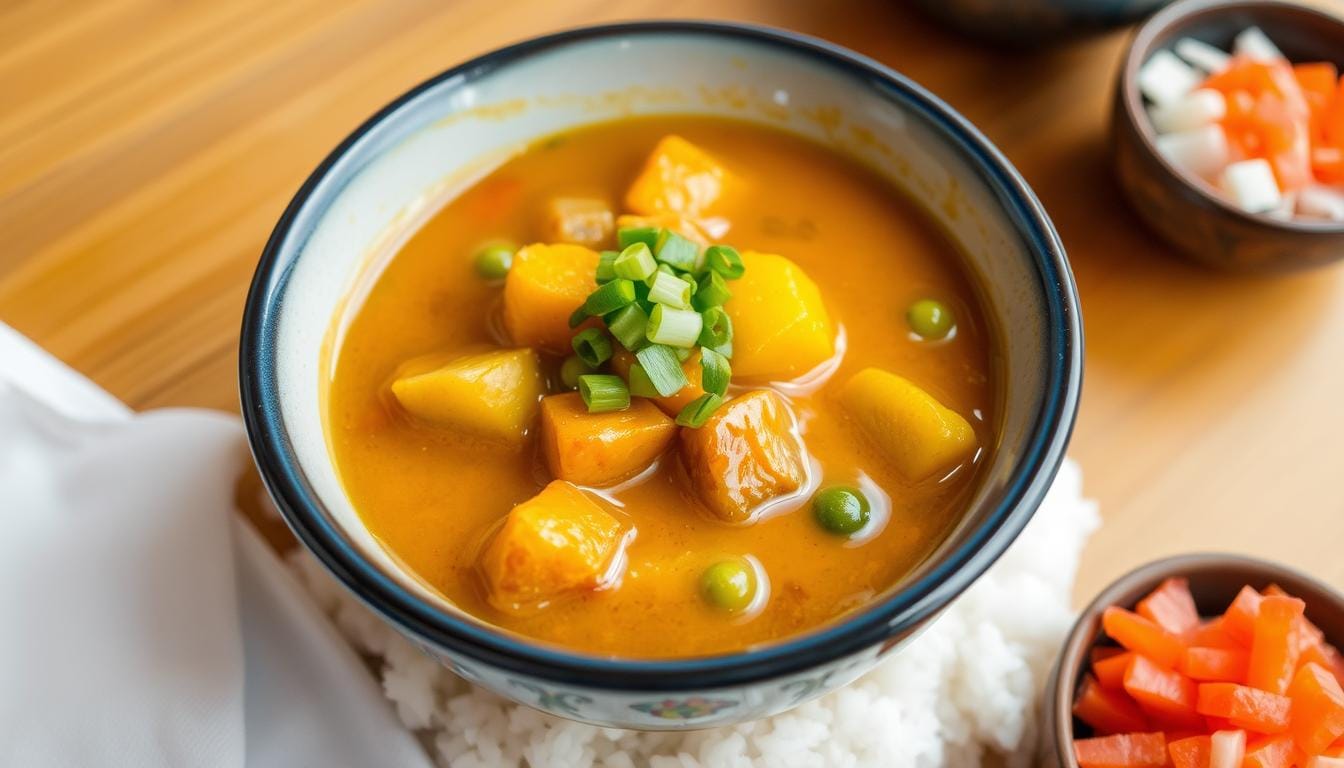golden curry recipe : The smell of spices and tender veggies fills the air, taking you to Japan’s busy streets. Japanese golden curry is a favorite dish loved by many worldwide. I’m thrilled to share a simple yet true recipe to make Japanese curry at home.
Curry rice, or kare raisu, has been in Japan since the Meiji era (1868-1912). It was brought from the British in India during colonial times. Over time, it became a beloved dish in homes and restaurants. Now, Japanese curry is seen as a national treasure, known for its special mix of sweet, savory, and slightly spicy flavors.
Table of Contents
What is Japanese Golden Curry?
Japanese curry, or kare raisu, is a special dish with a unique taste. It’s different from Indian and Thai curries. This stew-like dish has sweet, spicy, and umami flavors. It’s creamy and thick, making it a comforting meal.
Introduction to Japanese Curry
The history of Japanese curry started in the late 19th century. It came from British and Indian influences. Over time, Japanese chefs and home cooks made it their own. Now, it’s a beloved national dish.
Unique Flavors and Ingredients
The core of Japanese curry is a curry roux. It’s made by sautéing spices and aromatics. Then, it’s mixed with a sauce, often with curry powder. This creates a complex flavor that’s both savory and sweet.
Difference from Other Curry Types
Japanese curry is different from Indian and Thai curries. It’s milder in heat and has a smooth texture. This makes it comforting for everyone. Plus, curry rice can be customized to suit your taste.
“Japanese people consume curry about 80 times per year on average, making it a staple in the national diet.”
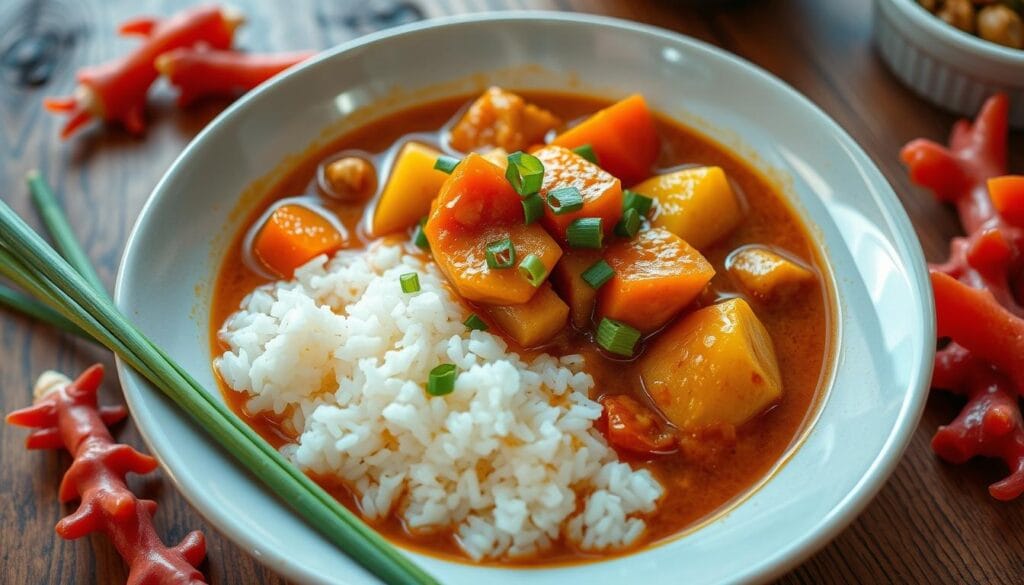
Essential Ingredients for Golden Curry
Making a real Japanese golden curry at home begins with the right ingredients. You need the aromatic vegetables and the flavorful curry roux. Each part is key to getting that golden color and rich taste. Let’s look at what you’ll need to make this tasty dish.
Key Components You’ll Need
- Protein: Stewing beef or chicken thigh fillets
- Aromatics: Onions, garlic, and ginger
- Vegetables: Carrots, potatoes, and apples
- Spices: Curry powder, garam masala, and turmeric
- Liquid: Chicken or beef broth, soy sauce, and Worcestershire sauce
- Thickening: Flour and butter
Recommended Brands for Curry Roux
The curry roux is the heart of the dish. There are many reliable Japanese brands to choose from. Golden Curry, Vermont Curry, and Java Curry are popular. These pre-made roux packets make it easy to get the perfect curry flavor and consistency.
Fresh Vegetables to Use
For vegetables, stick to classics like onions, carrots, and potatoes. They add sweetness, crunch, and starchiness that goes well with the curry. Diced apples add a touch of natural sweetness.
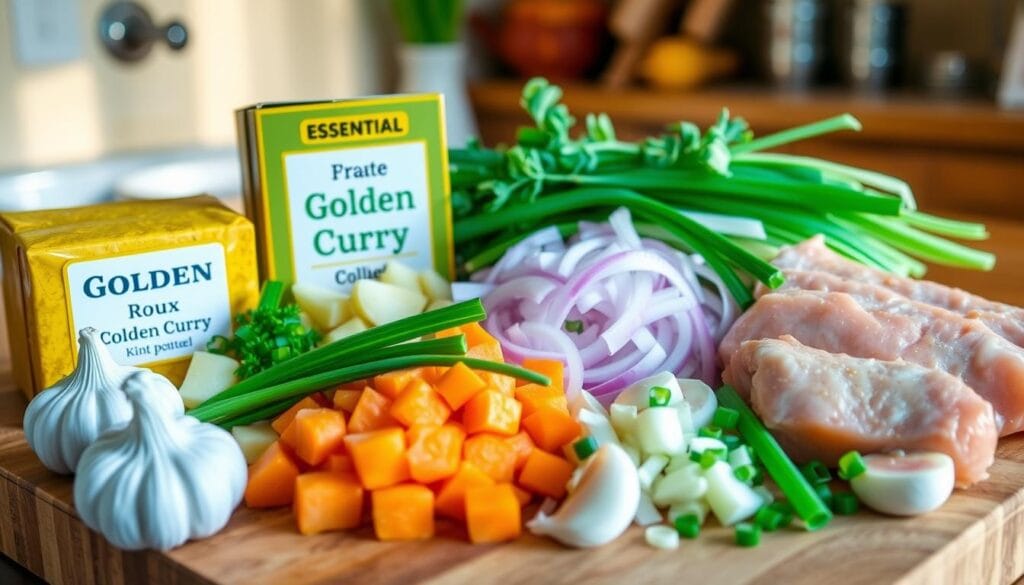
Knowing the essential ingredients for golden curry helps you make a delicious homemade version. This version captures the essence of this beloved Japanese dish.
Choosing the Right Protein for Your Curry
Choosing the right protein is key to a great Japanese golden curry. Whether you love meat or prefer plants, there are many tasty options. Each one can change the flavor and texture of your dish.
Options for Meat Lovers
Classic Japanese curry often has chicken, pork, or beef. Boneless, skinless chicken thighs are a favorite. Thinly sliced pork from the shoulder adds a tender texture. For a deeper flavor, try venison or beef.
Vegetarian and Vegan Alternatives
- Firm tofu, air-fried or pan-fried until golden, is a tasty addition to vegetarian curry.
- Chickpeas or mushrooms are great protein options for plant-based curries.
- For a twist, try breaded and deep-fried cutlets like chicken katsu or pork tonkatsu.
Enhancements with Seafood
Adding shrimp or squid gives a seafood twist to Japanese golden curry. But, cook seafood separately and add it just before serving to avoid overcooking.
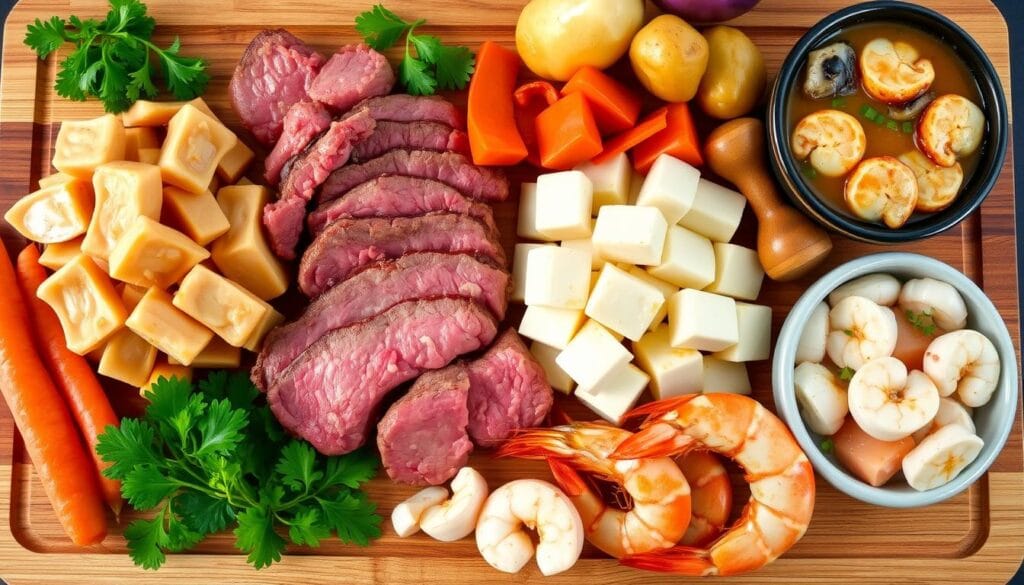
“The beauty of Japanese curry lies in its versatility – you can experiment with a variety of proteins to create a unique and satisfying dish that caters to your personal preferences.”
Preparing Your Vegetables
To make the perfect Japanese golden curry, start by preparing your vegetables right. The way you cut them is key. It ensures they cook evenly and adds to the dish’s texture.
Cutting Techniques for Even Cooking
When cutting vegetables, aim for consistency. Cut them into pieces that are all the same size and thickness. This helps them cook evenly, so no piece is overcooked or undercooked.
Uniform cutting also makes your curry look better.
Recommended Vegetable Combinations
The classic mix for Japanese golden curry includes onions, carrots, and potatoes. These ingredients give a great base of flavors and textures. You can also add other veggies like broccoli, bell peppers, or green beans.
Apples can add a sweet touch, balancing the savory curry flavors.
Choosing vegetables is up to you. Try different mixes to find what you like best. Just make sure to cut them carefully so they cook well and add their flavors to the curry.
“The secret to a truly exceptional Japanese golden curry lies in the thoughtful preparation of the vegetables. Take the time to slice and dice them with precision, and you’ll be rewarded with a harmonious, well-balanced dish.”
Making Your Golden Curry Base
Creating the perfect Japanese golden curry begins with a flavorful base. Start by sautéing onions, garlic, and ginger until they’re translucent. This step is crucial for the curry’s rich taste.
Steps to Sauté Aromatics
- Heat a large skillet or Dutch oven over medium heat and add a tablespoon of oil.
- Finely chop the onions, garlic, and ginger, then add them to the hot oil.
- Sauté the aromatics, stirring occasionally, until they become fragrant and the onions are softened, about 5-7 minutes.
- For an extra layer of sweetness, grate in a small Fuji apple and continue cooking for 2-3 minutes.
Importance of Cooking Time
Cooking the aromatics for a longer time enhances the flavors. Take your time with this step. It’s key for a rich, authentic taste of Japanese curry base. Don’t rush it – the extra effort will be worth it.
Adding Flavor Depth with Spices
After the aromatics are softened, add the spices. Mix in Japanese curry powder and garam masala. These spices add a warm, aromatic complexity to the curry base. You can also add a tablespoon of tomato paste and a splash of red wine for more flavor.
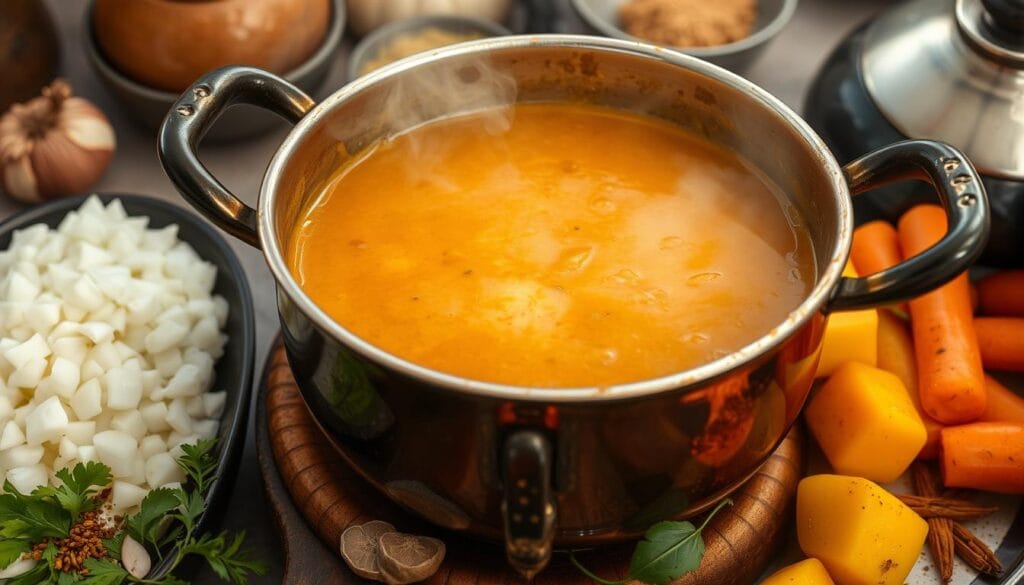
“The secret to a truly exceptional Japanese curry lies in the careful development of the base – it’s where the magic happens.”
How to Cook Your Protein
Cooking your protein right is key to a great Japanese golden curry. You can use meat, seafood, or even vegetarian options. Learning the right cooking methods makes your protein tender and full of flavor.
Techniques for Perfectly Cooked Meat
For meat-based curries, cook the protein first. This way, you can get the perfect texture and taste. Beef needs about an hour to become tender. Chicken cooks faster and can go straight into the curry.
Managing Cooking Times
- First, sear or brown your meat to keep the juices in and get a nice crust.
- Change the cooking time based on the protein’s size and thickness. Thicker pieces need longer, while thinner ones can go in later.
- Watch your protein closely as it cooks. Be ready to adjust the heat or time to avoid overcooking.

Mastering protein cooking is a big step towards a top-notch Japanese golden curry. Try different proteins to find your favorite.
Incorporating the Curry Roux
Creating the perfect Japanese golden curry starts with the curry roux. This key ingredient makes the dish thick and flavorful. Here’s how to add it for a smooth sauce.
When to Add the Roux
Add the curry roux towards the end of cooking. This lets it dissolve fully into the curry. Mix the roux cubes with hot liquid before stirring into the pot. This method avoids lumps in your sauce.
Stirring Techniques for Smooth Sauce
Stir well when adding the curry roux. Stir the curry for a few minutes to avoid lumps. The roux thickens the curry, making it velvety. Take your time to get the perfect texture.
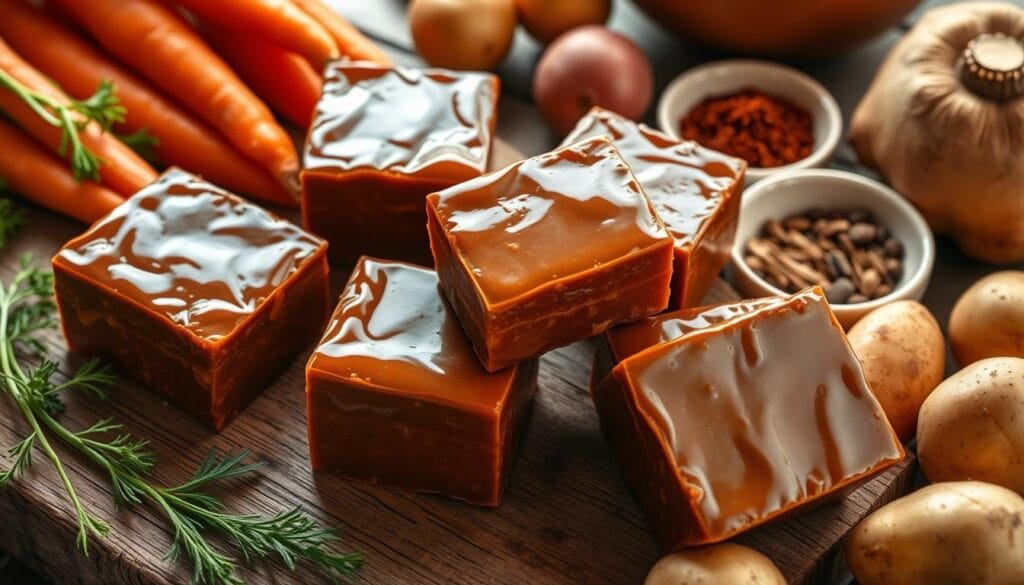
“The key to a perfect Japanese golden curry is all in the curry roux. Take your time to dissolve it properly for a silky smooth sauce.”
Mastering the curry roux technique will help you make a delicious Japanese golden curry. Be patient and careful during this step for the best results.
Adjusting the Thickness of the Curry
Getting the right curry thickness is key for a great dish. You might like it thick and gravy-like or light and smooth. There are ways to change your Japanese golden curry’s thickness.
Thickeners to Consider
If your curry is too thin, you can add thickening agents. Here are some options:
- Flour or cornstarch: Mix a tablespoon of flour or cornstarch with water. Then, slowly whisk it into the curry.
- Coconut cream or milk: Using coconut cream or milk can make the curry thicker by reducing liquid.
- Ground nuts: Peanuts or cashews add a nutty taste and thickness.
- Starchy vegetables: Cooking potatoes and sweet potatoes releases starches, thickening the curry.
How to Avoid a Watery Curry
To avoid a watery curry, balance liquid and ingredients well. Here are tips:
- Don’t add too much liquid at first. Start with the right amount of water or stock and add more if needed.
- Simmer the curry uncovered to let the liquid reduce and thicken.
- Blend some cooked ingredients for a smooth, velvety texture.
- Add diced or mashed potatoes to soak up excess moisture and thicken the sauce.
Experiment and adjust the thickness until it coats the ingredients perfectly. This will make your Japanese golden curry delicious and satisfying.
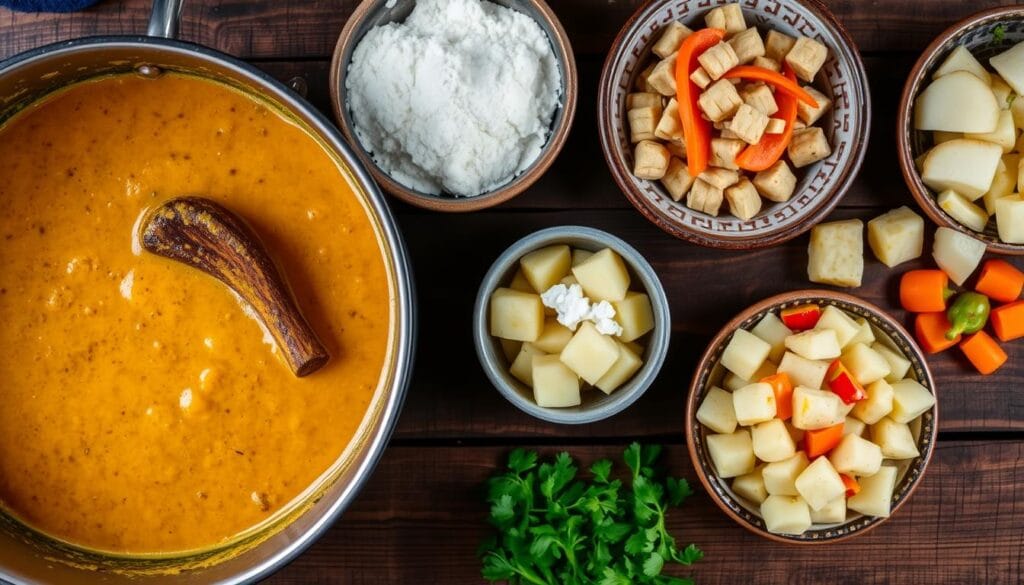
Serving Suggestions and Pairings
When serving homemade Japanese golden curry, you have many options. The goal is to find accompaniments that balance the curry’s bold flavors. They should also enhance its unique spice.
Best Rice Options for Your Curry
Short-grain white rice is the classic choice for Japanese curry. It soaks up the sauce well. But, you can also try:
- Brown rice for a nutty, wholesome taste
- Udon noodles for a hearty, chewy texture
Accompaniments that Enhance Flavor
To make your curry experience better, add toppings or side dishes. They should offer contrasting textures and flavors. Here are some great options:
- Fukujinzuke – Pickled Japanese vegetables for a tangy, crunchy contrast
- Curry ramen or curry udon for a unique twist
- Curry-filled bread, or curry pan, for a special treat
By choosing the right rice and accompaniments, you can make a meal that’s both satisfying and balanced. It will highlight the best of Japanese golden curry.
Tips for Storing Leftovers
Enjoying a delightful Japanese golden curry doesn’t have to end when the meal is over. With proper storage techniques, you can savor the flavors of your homemade curry for days to come. Here are some valuable tips to ensure your leftovers stay fresh and flavorful.
Refrigeration Guidelines
To store your leftover golden curry, transfer it to an airtight container and place it in the refrigerator. Your curry will stay fresh for up to 5 days when stored this way. For longer-term preservation, consider freezing your curry in individual portions. This will allow you to enjoy your curry for up to 2 months.
Reheating Tips for Best Results
When you’re ready to enjoy your refrigerated or frozen curry leftovers, the key is to reheat them gently. For best results, thaw frozen curry overnight in the refrigerator before reheating. Then, gently warm the curry on the stovetop or in the microwave, adding a splash of water if needed to maintain the desired consistency.
By following these simple tips for storing curry and reheating leftovers, you can savor the rich flavors of your homemade Japanese golden curry long after the initial meal. Enjoy every bite, knowing that you’ve mastered the art of preserving and reviving your culinary creation.
“The best part about making a big batch of curry is enjoying the leftovers all week long. With the right storage and reheating techniques, you’ll never get tired of this comforting dish.”
Variations of Golden Curry
The beauty of Japanese golden curry is its versatility. It has many regional adaptations and personal touches across Japan. Explore the diverse curry variations that show the country’s culinary creativity.
Regional Adaptations in Japan
Japanese curry varies by region. For example, Sapporo curry from Hokkaido is spicy and rich, often made without commercial curry roux. Katsu curry, with a deep-fried cutlet, is loved all over Japan.
Creative Ideas for Personalization
- Try different vegetables or proteins to make your own curry variations. You can use tender beef or crisp veggies.
- Add your own touch with honey for sweetness or ichimi togarashi for heat. These can make your regional curry even better.
- Use different curry roux for unique flavors. Try the classic S&B Golden Curry or plant-based options.
“The joy of cooking Japanese curry is in the freedom to experiment and make it your own. Embrace the endless possibilities and let your creativity shine through.”
Whether you’re trying curry variations or making your own regional curry, Japanese golden curry is a tasty canvas for your culinary adventures. Dive in and find the unique flavors waiting for you.
Conclusion and Final Thoughts
Homemade Japanese golden curry is a rewarding dish to make. By following this guide, you can create a delicious curry. It will have the velvety texture and balanced flavors of a Japanese staple.
Recap of Key Steps
Preparing the aromatic base is key. Then, adding the perfect curry roux is crucial. Remember to marinate your protein and sauté the vegetables well.
Simmer the curry for enough time. This lets the flavors meld and deepen.
Encouragement to Experiment with Your Recipe
Homemade curry is all about personalizing it. Try different proteins, vegetables, and spice blends. This way, you can create your own unique Japanese golden curry.
With practice and creativity, you can make this dish even better. Turn it into your own special recipe.

